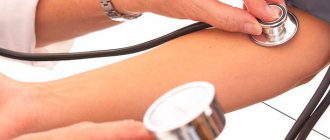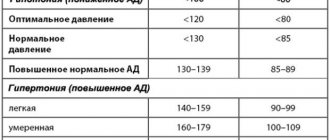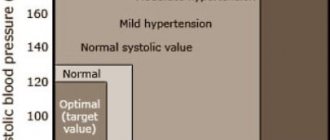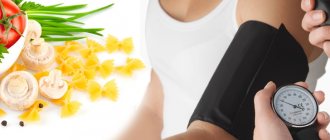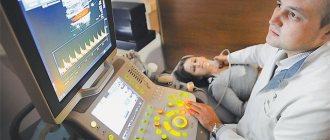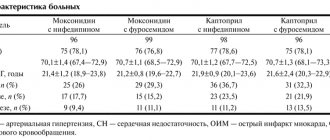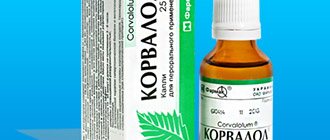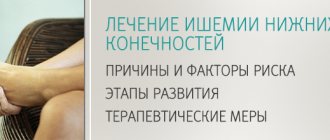Blood pressure directly depends on physical activity, the state of the cardiovascular system, and bad habits. However, not every hypertensive or hypotensive person associates surges in blood pressure (blood pressure) with their daily diet. But food can cause both a decrease and an increase in blood pressure, worsening or improving the patient’s well-being. At the same time, the list of products that increase and decrease blood pressure is individual for everyone, but there are general rules that should be followed in case of problems with well-being.
Why does blood pressure change after eating?
When food enters the digestive tract, the processes of its assimilation and digestion begin, and the production of gastric juice, enzymes and enzymes begins. The blood is enriched with nutrients and is supplied with redoubled force to the gastrointestinal tract to enhance metabolic processes. At this time, the plasma volume increases, the number of red blood cells in the blood decreases significantly.
Whether the pressure will increase and by how much depends on a number of factors. The main reasons for the increase: thick blood (the thinner it is, the lower the risk of a jump in blood pressure), the presence of plaques and blood clots in the vessels that impair blood movement. In this case, a person feels all the symptoms of high blood pressure - headache, increased pulsation, nosebleeds may occur, anxiety and irritability may appear.
If your blood pressure drops after eating, which is typical not only for hypertensive patients, but also for hypotensive patients, then the symptoms are somewhat different. Vision becomes blurred, nausea appears, dizziness, severe general weakness and drowsiness are felt.
In both the first and second cases, measure the pressure that rises or falls and take measures to stabilize the condition. You should pay attention to exactly what foods you consumed before the attack, and try to temporarily exclude them from your daily diet. It would be useful to consult a doctor who can assess the state of the cardiovascular system, prescribe treatment and give nutritional recommendations.
But if a healthy person does not feel the changes occurring in the body, then a chronic hypertensive patient or a patient in a pre-infarction state can often feel the full force of the influence of the usual food on blood pressure. Why a certain product affects your well-being can only be found out after a medical examination.
Important! It is necessary to decide on foods that can increase or slow down the heartbeat, raise or lower blood pressure, and also include foods that stabilize blood pressure in the menu.
Symptoms
Manifestations of postprandial hypotension are similar to those of other forms of the disease. The patient develops the following symptoms:
- starts to hurt and feel dizzy;
- heart rate increases;
- I feel sleepy and feel very weak;
- increased sweating occurs;
- chest pain is felt;
- visual and speech disturbances are possible.
Important information: Is it possible to shower and bathe with high pressure?
If the pressure drops too quickly, the person may faint. Such falls are dangerous in old age, as they often lead to serious injuries.
Worst foods for hypertensive patients
If your blood pressure rises after eating due to hypertension, then you should avoid a number of foods. With low blood pressure, such food, on the contrary, will serve as a kind of energy drink, increase tone and relieve characteristic weakness.
The list of foods and drinks that typically increase blood pressure includes:
Does coffee increase blood pressure?
- Salted fish, smoked meats, preserves. Such foods are oversaturated with salt, which promotes fluid retention in the body and for this reason increases blood pressure.
- Dairy products with high fat content. They have the ability to thicken the blood, which is useful for low blood pressure and unacceptable for high blood pressure.
- Red fried meat, baked goods, sweets. High-calorie foods provoke excess weight gain. And hypertension almost always becomes a companion to obesity.
- Alcoholic drinks. Ethanol sharply constricts blood vessels, which can cause a surge in blood pressure. At the same time, the pulse quickens, which is dangerous for any form of hypertension.
- Tonic drinks. These include coffee, black tea, all kinds of energy drinks, which not only increase blood pressure, but also provoke attacks of tachycardia.
Of course, you shouldn’t completely give up your favorite baked goods, morning cup of tea or glass of dry wine. However, it is worth minimizing the consumption of the above products and monitoring your condition after eating or drinking.
No ads 1
What research should I do?
1. Take a general blood test, C reactive protein - to exclude persistent laboratory inflammatory syndrome. If myocarditis is suspected, additionally test for rheumatoid factor and Troponin.
2. Donate blood for vitamin D, iron, ferritin (if the level of these indicators is low, weakness and tachycardia will bother you for a long time).
3. Make an ECG (assess the heart rhythm, heart rate at rest, focal changes in the myocardium).
4. Do an echocardiography (exclude organic changes in the heart, fluid in the pericardium of the heart, signs of myocarditis, evaluate the contractility of the heart)
5. Do a Holter ECG for 24 hours (may be additionally recommended by your doctor).
6. If myocarditis is suspected, the gold standard for diagnosis is cardiac MRI with contrast.
Blood pressure lowering products
If your blood pressure rises after eating, it makes sense to reconsider your diet and fill it with food that normalizes your condition and strengthens blood vessels. These include:
- spinach;
- raw almonds;
- bananas;
- white beans;
- potato;
- turmeric;
- Cayenne pepper;
- sunflower seeds;
- low-fat dairy products;
- ginger;
- green tea;
- chokeberry;
- black chocolate.
Such food has a beneficial effect on blood pressure, normalizes heartbeat, and prevents the formation of plaques on the walls of blood vessels. But it is not able to have a pronounced effect on pressure in the form of a sharp drop.
Citrus fruits, consumed in large quantities, have an excellent ability to lower blood pressure.
What foods to include in your diet to increase blood pressure
Since in postprandial hypertension the cause of a decrease in blood pressure is food intake, it is necessary to correctly formulate the diet and include in it foods that can increase blood pressure:
- Use pickles and marinades in small quantities, so that the total amount of salt does not exceed 15-20 g per day. Sodium retains water and increases blood circulation.
- Spices and herbs increase the secretion of the digestive glands and contribute to the narrowing of the vascular walls.
- The amino acids contained in nuts are beneficial for patients with postprandial hypotension.
- The menu should include vitamins C and B (eggs, liver, yeast, berries), as well as fruits that tone the body - lettuce, celery, sour apples, cabbage.
- Fatty foods increase the concentration of cholesterol in the blood, resulting in increased blood pressure.
- If your blood pressure drops sharply, you can drink a cup of coffee, strong tea, or energy drink.
Foods high in carbohydrates (baked goods, fried potatoes, pasta) help lower blood pressure. Insulin and other substances that are released when it is consumed dilate blood vessels, causing a drop in blood pressure. The development of hypotension is also provoked by a large amount of sugar and its substitutes.
Important information: What are the main risk factors for hypertension?
You need to carefully plan your diet for postprandial hypertension - abuse of fatty foods, spices, and salt can provoke other diseases. In addition, they contribute to excess weight gain, which worsens the condition of the cardiovascular system. You need to eat in small portions, avoiding hunger or overeating. After eating food, it is better not to get up from the table, but to sit quietly for 30-40 minutes. To normalize the condition, it is important to drink a lot - the volume of liquid should not be less than 1.5-2 liters per day.
Even if your blood pressure regularly drops after eating, you should not refuse food, as this can lead to a worsening of the condition. You need to have a full breakfast, lunch, and dinner, following the doctor’s recommendations for creating a diet.
Additional nutrition tips
If you experience regular changes in blood pressure after eating, you should follow a few simple rules that are also relevant for healthy people.
- Avoid overeating. You can eliminate the absorption of excessive amounts of food by eating small and often. The optimal solution is 5 meals a day in portions not exceeding 300 ml in volume.
- You shouldn't eat before bed. The last meal should be no later than 1-3 hours. Sleeping on a full stomach will be restless, and the body will need more energy to digest food, which can cause an increase in blood pressure.
- Fasting for hypertension or hypotension is excluded without consultation with the attending physician.
- The best way to prepare food is steaming, the worst way for vascular health is frying.
- It is important to maintain a drinking regime, drinking 1.5–2 liters of clean water per day. For chronic hypertensive patients, these numbers should be reduced, since a large amount of fluid can raise blood pressure.
- You should exclude carbonated drinks, fast food, unhealthy sweets, and canned food from your diet.
- The proportion of fiber-rich foods should increase.
- The main components of the plate should be vegetables, herbs, fruits, dairy products, lean meats and fish.
- If you feel that your blood pressure is rising after eating something, or your heart rate is increasing, you should measure your blood pressure and take the medications recommended by your doctor to stabilize your condition.
Advice! Coffee, tea, and alcoholic drinks should be replaced with water, juices, fruit drinks and compotes based on vitamin-rich fruits and berries.
No ads 2
Does your blood pressure drop after eating? The culprit is... intestinal bacteria!
Does your blood pressure drop after eating? The culprit is... intestinal bacteria!
Photo: GLOBAL LOOK PRESS
Researchers from Johns Hopkins University and Yale University have found that the receptors that are located in the nose, that is, the olfactory ones, turn out to line the walls of blood vessels throughout the body. And their activity directly depends on the bacteria that live in the intestinal microflora. We won’t bore you with the details of the chemical processes, but the point of the study is that after eating, bacteria begin to produce a substance that makes the receptors work. And because of this, the pressure decreases! Moreover, bacteria begin to be produced after eating plant foods.
“We are only at the beginning of the journey, having identified the key players and the main ways of their interaction,” says study author Pluzhnik. “We don’t yet know what the benefits of lowering blood pressure after eating are and why intestinal bacteria play the role of moderators of this process. But our work opens the door to research on the relationship between antibiotic and probiotic therapy and other factors affecting the intestinal microflora and blood pressure levels.
“There is so-called idiopathic, that is, unidentified hypertension (hypertension), the causes of which are virtually impossible to determine,” says Ph.D., neurologist Viktor Koss. – And it accounts for approximately 40, or even 50 percent of all cases of hypertension. Perhaps it is really related to the work of the intestinal microflora. At the moment, only the connection between pressure and the work of the kidneys, which produce the substance angiotensin, which causes vasospasm and increases blood pressure, has been clearly proven. This factor is regulated by drugs based on ACE inhibitors. Hypertensive patients are also prescribed diuretics, drugs that remove water from the body. This mechanism is based on the action of a cardiac hormone, which begins to be produced when pressure increases, and forces the body to dump excess water. The new study is also supported by the fact that the microflora of the large intestine is responsible for the production of many vitamins and blood clotting factors. But it must be said that according to the teachings of Chinese medicine, the large intestine is directly connected to the lungs, which at the moment have not actually been studied. But it is known for sure that breathing exercises, which were invented by the Chinese centuries ago, help both the functioning of the lungs and the functioning of the intestines. And, of course, they regulate the pressure.
Can hypotensive people eat anything harmful?
“Women’s blood pressure is slightly lower than men’s, and in case of vagaries of weather and monthly hormonal fluctuations, its decrease can be significant,” says our expert, nutritionist Lyudmila Denisenko. – Moreover, it occurs more often in women under 35 years of age. As a rule, people with low blood pressure feel well, i.e. do not feel arterial hypotension. Sometimes, to improve your well-being, it is enough to change your lifestyle: normalize sleep, the nature of work and rest, take up swimming or other sports. But there is pathological hypotension (systolic blood pressure below 90 mm Hg, diastolic blood pressure below 60 mm Hg) primary and secondary. The second occurs with pulmonary tuberculosis, rheumatism, osteochondrosis of the cervical spine and other diseases. All hypotensive patients from time to time experience drowsiness, weakness, fatigue, darkening of the eyes when standing up, headache and dizziness, up to loss of consciousness due to a sharp drop in blood pressure. Can a special diet help them?
Many sites recommend the most harmful diet for hypotensive people - an abundance of canned food, fatty foods, both fish and meat, soda, a lot of pickled and salty foods. But our expert disagrees with this:
— Yes, theoretically, nutrition for hypotension should be the opposite of the diet for primary arterial hypertension, where the main rules are limiting table salt and increasing potassium intake. But it would be very strange to eat intensely, while gaining extra pounds, considering that hypotension can also occur with obesity. Or give up berries, fruits, and dairy products. The only rule that hypotensive patients should adopt is increased salt consumption (unless, of course, there are concomitant diseases in which excess sodium is contraindicated).
There is no special diet for people with arterial hypotension; there are no restrictions on foods or methods of cooking food. One thing is important - adherence to the principles of healthy eating. You should not try to “strengthen” your health through inadequate food rations of various types of non-traditional nutrition (raw food diet, macrobiotics, according to blood groups, etc.) or “preventive” fasting. It is known that even with short-term fasting, secondary arterial hypotension is possible in people who had normal blood pressure. Therefore, nutrition for hypotension should be simply healthy, without any special dietary restrictions, and include:
- more vegetables, especially fresh green ones,
- whole grains, legumes,
- high-quality fats, sea fish, eggs, chicken,
- some unpasteurized goat milk products,
- fruits,
- unroasted nuts and seeds.
Any hydrogenated fats, synthetic additives, and especially sugar substitutes for hypotension are categorically excluded; Sugar and refined grains are highly discouraged. A patient suffering from low blood pressure should definitely drink plenty of fluids, at least 30 ml per kilogram of weight per day.
For some, with a feeling of heaviness in the head, headaches, general weakness and apathy, strong tea or black coffee gives a quick but short-term effect, to a lesser extent - Coca-Cola, cocoa, strong low-fat broth, dark chocolate. But remember, a “yo-yo effect” may occur when, instead of vigor, drowsiness appears. And therefore, the first and most important thing that a person prone to hypotension should do is, oddly enough, to completely stop using stimulants: alcohol, tobacco, coffee, tea, Coca-Cola, ephedrine, ginseng and other stimulants. All these substances deplete the body, returning strength for a while, and then increasing fatigue and weakness.
For hypotension, it makes sense to pay special attention to spices, especially hot ones: cayenne pepper, chili. And also cinnamon. Soy is not recommended at all for low blood pressure.
And for hypertensive patients - eat 4-5 times a day
“Hypertension is one of the most serious factors that can lead to heart attacks, strokes, heart and kidney failure,” continues Lyudmila Denisenko. “That’s why there are much more dietary restrictions.” than in hypotensive patients. Special diets have been developed (see below), but we will list some mandatory factors:
- The amount of fat in the diet is reduced (65-75 g), they are partially replaced by vegetable oil (corn, sunflower, soybean, olive), which is rich in polyunsaturated fatty acids and lecithin.
- The amount of protein in the diet must correspond to the norms (i.e. 1.2-1.5 g per 1 kg of body weight per day).
— The carbohydrate content in the diet is not limited. But still, eat less easily digestible carbohydrates - sugar, honey, jam, confectionery, etc. Replace them with unsweetened varieties of fruits, berries, vegetables, etc.
- More plant fiber - it helps eliminate cholesterol. That is, more vegetables, fruits and berries, depleted in sodium salts and rich in potassium, magnesium, and vitamins. And it is advisable to eat at least a clove of garlic a day - it helps to slightly dilate blood vessels.
— Limit salt to 4-6 g per day. In this regard, products containing a lot of salt (herring, pickles, marinades, etc.) are contraindicated.
— The amount of fluid should not be limited unless there is circulatory failure.
— Vitamins (bioflavonoids, niacin, ascorbic acid, riboflavin, pyridoxine) that support vital body functions. But calciferols, which contribute to the development of atherosclerosis, should be limited.
— Minerals: potassium ions, magnesium, iodine. Potassium with a relatively low sodium content is rich in vegetables, fruits, berries, cocoa powder, achloride bread, lamb, beef, etc. Magnesium - beans, peas, soybeans, green peas, raisins, figs, rose hips, dates, wheat, rye, corn, dried apricots. Iodine - seafood (seaweed, shrimp, squid, mussels, crabs, etc.).
— Limit products that have coagulating properties (cream, sour cream, butter, etc.), rich in biogenic amines (cheeses, salted fish, pickled herring, beans, bananas, pineapples, tomatoes).
- Eliminate foods that stimulate the central nervous system, heart activity (meat and fish broths and gravies, strong tea, coffee, cocoa, chocolate, alcohol) and irritate the kidneys (spicy snacks, seasonings, smoked meats).
- Meals should be small meals - four to five times a day, with the last meal no earlier than two to three hours before bedtime. The main one is diet No. 10. And in severe cases, especially in the presence of circulatory failure, diet No. 10a is indicated.
Sample one-day diet menu No. 10.
1st breakfast: cream cheese (120 g), semolina milk porridge (150 g), tea with milk (200 ml).
2nd breakfast: fresh apples (100 g), low-fat kefir (150 g)
Lunch: vegetarian pearl barley soup with vegetables (250 g), boiled meat with carrot puree (55/150 g), apple compote (200 g).
Afternoon snack: rosehip decoction (200ml), whole grain bread
Dinner: boiled fish with boiled potatoes (85/150 g), pilaf with fruit (90 g), tea with milk (200 ml).
At night: yogurt (200 g).
For the whole day: wheat or bran bread (250 g), sugar (50 g).
Approximate one-day diet menu No. 10 a.
1st breakfast: pureed buckwheat porridge (280 g), milk (100 g).
2nd breakfast: baked apples with sugar (120 g).
Lunch: boiled beef stroganoff (55/110 g), boiled potatoes (150 g), apple compote (200 g).
Afternoon snack: soaked dried apricots (50 g).
Dinner: baked carrot and apple balls (230 g).
At night: rosehip decoction (200 ml).
For the whole day: salt-free wheat bread (150 g), sugar (40 g), butter
(10g).
Against the background of the main diet, it will be good, especially in case of obesity and circulatory failure, to use fasting days once or twice every 7-10 days - rice-compote, salad, watermelon, cucumber, etc.
Pressure control
Many people are concerned about whether it is possible to measure blood pressure immediately after eating. Since food slightly increases blood pressure after consumption, it is better to wait 30-60 minutes before taking measurements. But this does not apply to situations where a person feels ill immediately after eating. It is only important to take into account that an increase in the usual indicators by 20 mm Hg. Art. is normal when you measure blood pressure immediately after a meal.
The risk that your blood pressure may rise and your heart rate may increase after eating increases with factors that contribute to hypertension, including the following:
- heredity;
- endocrine disorders;
- nervous system disorders;
- renal failure;
- psychical deviations;
- old age (over 65 years);
- diagnosed cardiovascular diseases;
- osteochondrosis.
If this is not the first time your blood pressure has risen, you should visit a doctor and purchase a tonometer that allows you to constantly monitor your condition and immediately stabilize it with special medications. To improve your well-being, it is necessary not only to relieve the symptoms of incipient hypertension or hypotension, but also to get rid of the root cause of this condition. Regular examinations by specialists and timely treatment of chronic diseases will help to avoid complications associated with changes in blood pressure.
Treatment of postprandial hypotension
Therapy must be comprehensive, including a certain lifestyle, proper nutrition, and medications.
Lifestyle
For any form of hypotension, it is necessary to maintain a healthy lifestyle and give up bad habits, especially smoking and drinking alcohol. Patients benefit from walking, physical therapy, swimming, and light physical activity. If you feel frequently unwell, you can wear special compression stockings that increase blood flow to the heart. They are selected depending on the individual characteristics of the body, adhering to the basic rule - the pressure should be distributed evenly. In the morning you should not get out of bed abruptly - you need to get up gradually, sitting on the edge for a while.
Traditional therapy
Conservative treatment for postprandial hypotension depends on the causes of the disease and the general condition of the person. To relieve symptoms, Levodopa, Octreotide, Midodrine, and other medications are prescribed; to improve the general condition, vitamins and restorative medications are prescribed. Caffeine-containing products, adaptogens, and tonics are effective. To achieve results, conservative therapy is combined with physiotherapy - massage, mud therapy, hydrotherapy. To reduce the manifestations of the disease, it is necessary to determine the underlying pathology and begin to eliminate it.
Attention! It is strictly not recommended to take any medications on your own when blood pressure drops - conservative therapy is selected after consultation with a doctor.

